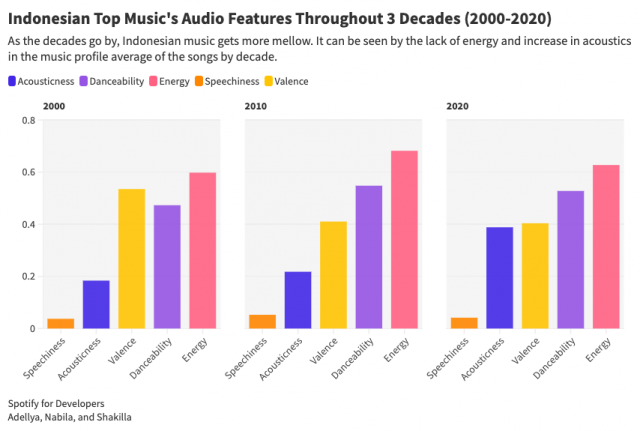Indonesian Music Characteristics Throughout The Years

Overview
For decades, music has shaped cultures and societies all around the world. Music has a very unique and interesting way of connecting with people. Music has become so influential in everyones’ life as people crave emotional connections and is an expression of people’s soul.
Music has the power to influence a person’s mood, perceptions, and motivate change. This article provides you with the kinds of Indonesian music that have been enjoyed by people throughout the three decades, which specifically focuses on the music characteristics and attributes that have potentially helped result in the rise of Indonesian music popularity.
Indonesian music from the early 2000s to early 2020s
The early 2000s was an era that transitioned between the physical and the digital mediums of music access and interest. It indicated the rise of digital media, albeit still overtaken by physical album sales such as records and cassette tapes that still thrived in Indonesia’s music industry. For instance, Sheila on 7 reached around 1.5 million copies (Audrey, 2020).
This scenario gave room for more diversity in the genres that were on the top charts in Indonesia’s general music scene, such as grunge rock and classic rock along with the occasional pop and techno genres. This is the reason the “band grunge” aesthetic, left over from the 80s and the 90s still reigned supreme.
In the early 2010s, music was still through DVDs and hardcopy. However, throughout the years, it transitioned to streaming platforms as Spotify was released in 2016. The 2010s data analysis shows that pop music has become the most favorable and preferred genre in Indonesia.
Generally, throughout the two decades, most of the songs are written about love and social life related to relationships such as “Sekuat Hatimu” and “Jaga Slalu Hatimu”. Indonesian-pop music with sad and mellow melodies continues to be very popular within the 2010s and has become the selling point of the music industry.
In the 2020s, most of the data was sourced all through streaming platforms; mainly through Spotify showed music profiling with a more mellow and toned-down beat than in previous eras. Indonesian jazz hit songs such as ‘Fine Today’ by Ardhito Pramono became popular. The 2020s highlighted the indie term ‘Skena’ with social media activists identifying Skena as fans criticizing those who enjoy other music genres- such as mainstream pop- more prevalent online than ever (Hayashi, 2023).
Indonesia’s Top Music Audio Features
Data from Spotify show that Indonesia’s top music in the past three decades has been dominated by energetic and danceable beats. Figure 1 below showcases the comparison of beat variety of Indonesian music from the 2010s to the 2020s. While energetic and danceability features remain high, the acoustical beat is getting more popularity.
The chart above explains the song profile’s average characteristics per decade. Below is an explanation of the song profile’s characteristics:
- Speechiness: The presence of spoken words or vocal content.
- Acousticness: The extent to which a track is dominated by acoustic elements instead of electronic or synthesized sounds.
- Valence: Musical positivity or negativity of a piece influences the emotional response it may evoke in listeners.
- Danceability: The suitability of a piece for dancing, considering factors like tempo, rhythm stability, and beat strength.
- Energy: The intensity and activity level of composition, with high energy, indicates a more dynamic and lively sound.
Another result from the Spotify data analytics shows that the beats per minute (BPM) of Indonesian music in the past decades have been decreasing. It shows that, Indonesians currently fancy mellow kinds of music. The chart below shows the evidence.
BPM which stands for “beats per minute” measures the tempo or speed of a piece of music. Specifically, it indicates the number of beats (rhythmic pulses or accents) in one minute of music. A higher BPM value generally corresponds to a faster-paced and more energetic piece, while a lower BPM suggests a slower and more relaxed tempo.
From the research done, it can be seen that the 2010 decade had the highest average BPM out of the three eras, with an average of 135 BPM against the 2000s and the 2020s, which had a similar BPM of 115 and 118, respectively. This can indicate the increase of popular songs being more upbeat and “pop” like in the Indonesian music industry.
Conclusion
In conclusion, the moods and the overall “vibes” of each era had quite a wide change in each transition, further proving the differences of each aesthetic that then show a wider picture of the country’s condition of the times. To put in simpler words:
- In terms of Valence, the 2000s had the highest average out of the three decades, showing a more “positive” mood and a lighthearted way to interpret the song, used for the more joyful experience in listening at the time.
- In terms of Energy and BPM, the 2010s reigned supreme, which is not to be confused with Valence because although they are faster in tempo and more upbeat-sounding, the message of the songs had a rise in a more somber and melancholic mood.
- In terms of Accousticness, the 2020s were the peak of sorrowful and almost desolating songs, an indication on the rise of prioritizing the generation’s mental health due to more external factors such as the COVID-19 pandemic and social media being the center of socializations.
Each decade of music had unique qualities that define each profile that made up the era of popular music in Indonesia– and that is why music is celebrated and shared diversely, we as a community keep doing so to keep the music charts dynamic and not boring throughout the generations.
References
Audrey, V. (2020, October 15). Industri Musik Indonesia Dulu dan Sekarang, Apa Sih Bedanya?. IDN Times. Industri Musik Indonesia Dulu dan Sekarang, Apa Sih Bedanya? (idntimes.com)
Hayashi, R. M. (2023, July 3). Skena di Antara Geliat Musik Independen Indonesia. Kumparan. https://kumparan.com/millennial/skena-di-antara-geliat-musik-independen-indonesia-20hV2zTiMta
Khurjekar, D. (2022, January 6). Investigating Spotify’s Danceability Index & Other song Attributes | By Dhruv Khurjekar | Jul, 2021 | Medium | Medium. Medium. https://dhruv-khurjekar.medium.com/investigating-spotifys-danceability-index-other-song-attributes-1983142f7dfd
Ngetren di 2010an. (n.d.). Spotify. https://open.spotify.com/playlist/37i9dQZF1DWY8wQ1UHaykc
Spotify. (n.d.-a). https://open.spotify.com/playlist/37i9dQZF1DX7nbWskw2fKF?si=3172d717211e4993
Spotify. (n.d.-b). https://open.spotify.com/playlist/37i9dQZEVXbObFQZ3JLcXt?si=26e18da6cb83451c
Contributors: Adellya A. Saelan – 2502005811; Nabila Aisha Wardhani – 2502048413; and Shakilla Ramadhan – 2502036836
Editor: Lily El Ferawati



